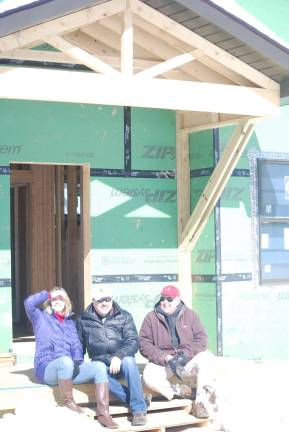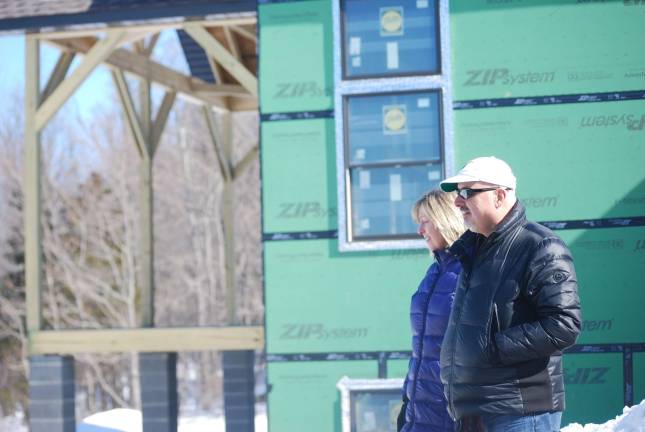The good life without the big footprint?






‘This is a Tesla. It’s an expensive project, but very efficient. But very expensive.’
By Becca Tucker
There are so many things to think about when designing a house – especially a house like this one – that some questions get left ‘til the end, when a couple looks at each other in a mild panic and asks:
Where the hell are we going to barbecue?
There was no door on the back of the house, Dixie Comeau and Greg Galluccio realized. Fortunately, the deck would work as a grill pit. The overhanging roof was so high overhead that cooking under it wouldn’t (knock knock) burn the house down.
The couple plans to host house concerts and do a lot of entertaining here – friends from Long Island have already laid claim to their guest rooms, although they’re still just cement cubes – so the question was not a trivial one. On the list of surprises since they broke ground, though, the barbecue situation was the latest, but not the biggest.
Last we knew, the pair was planning to buy an 1860 post and beam barn from Ontario, have its pieces trucked to their six acres on Distillery Road in Warwick, where they would be reincarnated into a house of razor-edge efficiency by the fall of 2016.
Then the drawing board met reality. There was no guarantee, they discovered, that the old barn beams could in fact support the structure – or even be level and plumb. “This effectively relegated the barn frame we’d purchased to a $114,000 indoor decoration,” wrote Comeau, on warwickbarn.blogspot.com, a blog dedicated to the house.
They canceled their order for the barn. Now that they finally had leeway to play with the house’s measurements, they ended up shortening it by six feet – and that was it. After all, they’d already had the architectural drawings done, and gotten used to picturing the house in their minds’ eye. Though it was not to be, the barn had actually provided a service by getting them past the daunting prospect of a blank page.
“It’s really hard to start with a blank slate,” said Comeau, a business consultant. “It’s easier to start with something else and make compromises.”
Another big surprise was the cost of heating the cavernous great room, notwithstanding the extra-thick cellulose insulation that will envelop the house. Even with two-by-sixes framing the walls, instead of the regular two-by-fours, “we way underestimated what that was going to be,” said Galluccio.
The great room is the house: it is living space, concert hall, recording studio. Galluccio, in addition to being vice president of an LED manufacturing company, is a guitarist with the Claudio Jacobs Band. Comeau’s lofted home office will double as mezzanine seating when their Carnegie Hall-level musician friends come to play, overlooking the grand piano below and Mount Eve beyond.
This churchlike room, with its 21-foot ceiling, is the tension point between the two dreams: where lofty aesthetics and tightfisted efficiency will have to find their meeting ground.
“Windows are the least efficient things you can put in,” said Galluccio, and yet they will have lots of them, as well as glass doors, to take in the ridgeline of Mount Eve. (Their contractor, green builder Thom Woglom, prevailed upon them to take the higher windows out of the design.) The way the swirling wind whips across the house, nearly taking one of the framers for a mid-air sail this winter, the frame actually flexes. They will be incorporating old barn beams to brace it.
This is all to say, the heating system is going to have to be a serious affair. It will consist of three parts, which will have to be wired to talk to each other. Electric-powered “mini-splits,” like you see in hotel rooms, will cool and heat from spring to fall, but when they really need heat in the winter, the propane is going to kick in, warming the great room’s radiant floor and forcing hot air out of ducts from the finished basement to the loft. The propane water heater is going to be ultra-efficient, and all the ductwork is kept away from the walls to minimize heat loss as hot air gets pumped around, but still… propane?
“Propane is 96 percent efficient,” said Woglom. “Solar is 14 percent efficient. So you need so much more product,” he said. “Things are changing so quickly, but electricity is not as efficient as fossil fuels. It’s a great supplement, but really is not a standalone – right now.”
Another obstacle to going net-zero is that people don’t always want solar panels to be front and center. “The people who can afford to do it don’t want to look right at it,” said Woglom. This house will be “solar ready,” equipped to plug right into an array to be installed on the roof of their future garage.
Sure, it would be easier to build a super-efficient house with a small footprint and low ceilings. But this couple wants to create something that’s not only efficient and lasting, but also beautiful. They want to show the world, said Comeau, that “being green doesn’t have to be like wearing sensible shoes.”